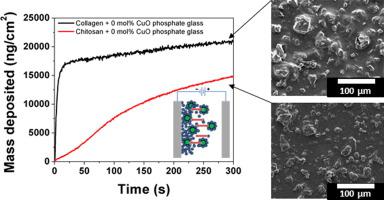Journal of Colloid and Interface Science ( IF 9.4 ) Pub Date : 2021-09-01 , DOI: 10.1016/j.jcis.2021.08.199 Imran Deen 1 , Gurpreet Singh Selopal 2 , Zhiming M Wang 3 , Federico Rosei 1

|
Coatings with bioactive properties play a key role in the success of orthopaedic implants. Recent studies focused on composite coatings incorporating biocompatible elements that can increase the nucleation of hydroxyapatite (HA), the mineral component of bone, and have promising bioactive and biodegradable properties. Here we report a method of fabricating composite collagen, chitosan and copper-doped phosphate glass (PG) coatings for biomedical applications using electrophoretic deposition (EPD). The use of collagen and chitosan (CTS) allows for the co-deposition of PG particles at standard ambient temperature and pressure (1 kPa, 25 °C), and the addition of collagen led to the steric stabilization of PG in solution. The coating composition was varied by altering the collagen/CTS concentrations in the solutions, as well as depositing PG with 0, 5 and 10 mol% CuO dopant. A monolayer of collagen/CTS containing PG was obtained on stainless steel cathodes, showing that deposition of PG in conjunction with a polymer is feasible. The mass of the monolayer varied depending on the polymer (collagen, CTS and collagen/CTS) and combination of polymer + PG (collagen-PG, CTS-PG and collagen/CTS-PG), while the presence of copper led to agglomerates during deposition at higher concentrations. The deposition yield was studied at different time points and showed a profile typical of constant voltage deposition. Increasing the concentration of collagen in the PG solution allows for a higher deposition yield, while pure collagen solutions resulted in hydrogen gas evolution at the cathode. The ability to deposit polymer-PG coatings that can mimic native bone tissue allows for the potential to fabricate orthopaedic implants with tailored biological properties with lower risk of rejection from the host and exhibit increased bioactivity.
中文翻译:

骨科植入物用掺铜磷酸盐玻璃电泳沉积胶原/壳聚糖薄膜
具有生物活性的涂层在骨科植入物的成功中起着关键作用。最近的研究集中在包含生物相容性元素的复合涂层上,这些元素可以增加羟基磷灰石 (HA)(骨骼的矿物质成分)的成核,并具有良好的生物活性和可生物降解特性。在这里,我们报告了一种使用电泳沉积 (EPD) 制造用于生物医学应用的复合胶原蛋白、壳聚糖和铜掺杂磷酸盐玻璃 (PG) 涂层的方法。胶原蛋白和壳聚糖 (CTS) 的使用允许在标准环境温度和压力 (1 kPa, 25 °C) 下共沉积 PG 颗粒,并且添加胶原蛋白导致 PG 在溶液中的空间稳定性。通过改变溶液中的胶原蛋白/CTS 浓度以及将 PG 与 0、5 和 10 mol% CuO 掺杂剂。在不锈钢阴极上获得了含有 PG 的单层胶原/CTS,表明 PG 与聚合物一起沉积是可行的。单层的质量取决于聚合物(胶原蛋白、CTS 和胶原蛋白/CTS)和聚合物 + PG 的组合(胶原蛋白-PG、CTS-PG 和胶原蛋白/CTS-PG),而铜的存在导致在在较高浓度下沉积。在不同时间点研究沉积产率并显示出典型的恒压沉积曲线。增加 PG 溶液中胶原蛋白的浓度可以实现更高的沉积产率,而纯胶原蛋白溶液会导致阴极产生氢气。











































 京公网安备 11010802027423号
京公网安备 11010802027423号